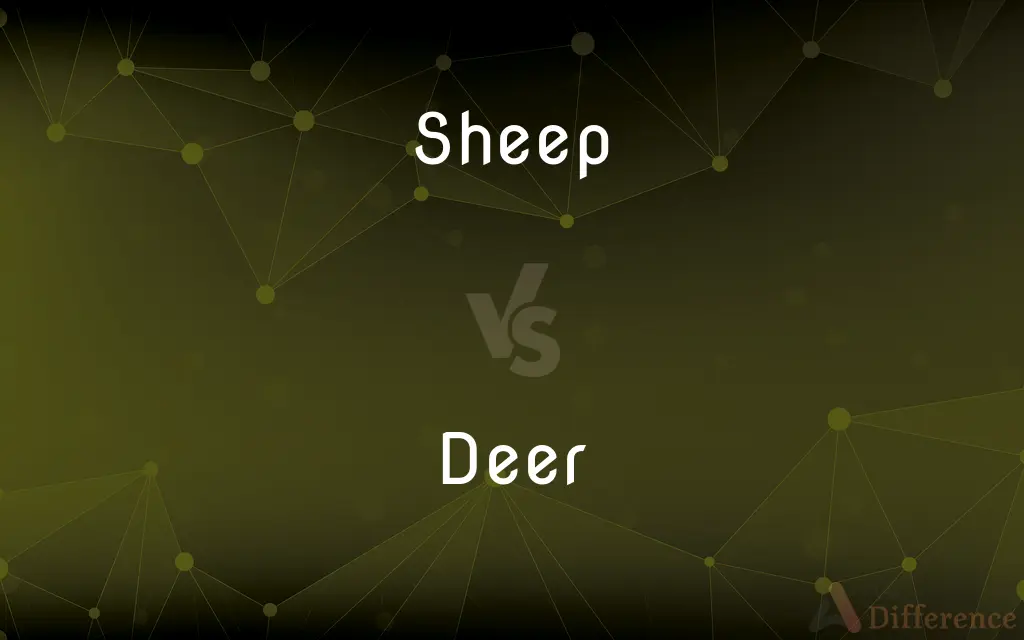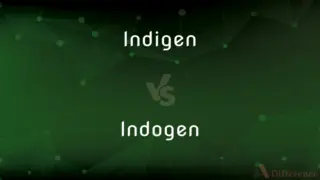Sheep vs. Deer — What's the Difference?
By Fiza Rafique & Urooj Arif — Updated on March 7, 2024
Sheep are domesticated animals raised for wool, meat, and milk, primarily grazing on pastures; whereas deer are wild, primarily forest-dwelling animals known for their antlers and are not domesticated.

Difference Between Sheep and Deer
Table of Contents
ADVERTISEMENT
Key Differences
Sheep are domesticated animals that have been an integral part of agriculture for thousands of years, providing resources such as wool, meat, and milk. They are typically kept in flocks and managed by humans. Deer, on the other hand, are wild animals that roam freely in various habitats, including forests and grasslands. They are known for their impressive antlers, which are found mostly on males and shed annually.
Sheep are primarily grazers, feeding on grass, clovers, and other ground vegetation. They play a crucial role in managing landscapes and can be used to control unwanted vegetation. Deer, whereas, have a more varied diet that includes leaves, twigs, fruits, and nuts. They are considered browsers rather than grazers, which influences the ecosystems they inhabit differently from sheep.
The social structure of sheep involves forming flocks, which provides protection and facilitates the management of their environment by humans. This social behavior is a key aspect of their domestication. Deer, on the other hand, can form herds, but their social structures are often more fluid, with some species leading more solitary lives except during mating seasons.
Sheep are bred and managed for their ability to produce resources efficiently, including selective breeding to enhance wool quality, milk production, or meat yield. Deer, whereas, are often pursued for game, conservation, or observation purposes. The management of deer populations is primarily focused on ecosystem balance and recreational hunting.
Regarding habitats, sheep are adaptable to a wide range of environments but are most commonly found in pastoral settings where they can be easily managed for agricultural purposes. Deer are adaptable to various environments but favor forests, meadows, and areas that offer cover and diverse food sources. Their presence in an area often indicates a healthy ecosystem.
ADVERTISEMENT
Comparison Chart
Domestication
Domesticated for wool, meat, milk.
Wild, not domesticated.
Habitat
Pastures, agricultural lands.
Forests, grasslands, meadows.
Diet
Grazers, feed on grass and clovers.
Browsers, feed on leaves, twigs, fruits.
Social Structure
Form flocks, managed by humans.
Form herds or live solitary, less human management.
Use by Humans
Bred for resources (wool, meat, milk).
Hunting, conservation, observation.
Compare with Definitions
Sheep
Known for their flocking behavior.
Sheep tend to stay close together for safety.
Deer
Deer are known for their agility and grace.
A deer can leap high fences with ease.
Sheep
Play a role in cultural and religious contexts.
Sheep are often a symbol of peace in many cultures.
Deer
Subject to game laws and conservation efforts.
Deer hunting seasons are regulated to ensure population health.
Sheep
Can have diverse breeds with various wool types.
Merino sheep are prized for their fine wool.
Deer
Deer have varied species with different habitat preferences.
The white-tailed deer prefers wooded areas.
Sheep
Domesticated ruminant farmed for wool, meat, and milk.
The farm's sheep provide wool for local artisans.
Deer
Wild mammals with distinct antlers, primarily males.
The majestic deer roamed freely through the forest.
Sheep
Sheep grazing is used to manage and fertilize lands.
The farmer uses sheep to naturally fertilize the fields.
Deer
Play significant roles in ecosystem balance.
Deer browsing helps control forest underbrush.
Sheep
Sheep (Ovis aries) are quadrupedal, ruminant mammals typically kept as livestock. Like all ruminants, sheep are members of the order Artiodactyla, the even-toed ungulates.
Deer
Deer or true deer are hoofed ruminant mammals forming the family Cervidae. The two main groups of deer are the Cervinae, including the muntjac, the elk (wapiti), the red deer, the fallow deer, and the chital; and the Capreolinae, including the reindeer (caribou), the roe deer, the mule deer, and the moose.
Sheep
A domesticated ruminant mammal (Ovis aries) having a thick coat, raised in many breeds for its wool, edible flesh, or hide.
Deer
Any of various hoofed ruminant mammals of the family Cervidae, characteristically having deciduous antlers borne chiefly by the males. The deer family includes the white-tailed deer, elk, moose, and caribou.
Sheep
Any of various wild ruminant mammals related to and resembling the domestic sheep, such as the aoudad, bighorn sheep, and mouflon.
Deer
A ruminant mammal with antlers and hooves of the family Cervidae, or one of several similar animals from related families of the order Artiodactyla.
Sheep
Leather made from the skin of one of these animals.
Deer
(in particular) One of the smaller animals of this family, distinguished from a moose or elk
I wrecked my car after a deer ran across the road.
Sheep
A person regarded as timid, weak, or submissive.
Deer
The meat of such an animal; venison.
Oh, I've never had deer before.
Sheep
One who is easily swayed or led.
Deer
Any animal, especially a quadrupedal mammal as opposed to a bird, fish, etc.
Sheep
(countable) A woolly ruminant of the genus Ovis.
Deer
Any animal; especially, a wild animal.
Mice and rats, and such small deer.
The camel, that great deer.
Sheep
The domestic Ovies aries, the most well known species of Ovis.
Deer
A ruminant of the genus Cervus, of many species, and of related genera of the family Cervidæ. The males, and in some species the females, have solid antlers, often much branched, which are shed annually. Their flesh, for which they are hunted, is called venison.
Sheep
(countable) A timid, shy person who is easily led by others.
Deer
Distinguished from Bovidae by the male's having solid deciduous antlers
Sheep
A religious adherent, a member of a congregation or religious community (compare flock).
Sheep
(uncountable) Sheepskin leather.
Sheep
A person who is easily understood by a speech recognition system; contrasted with goat.
Sheep
Any one of several species of ruminants of the genus Ovis, native of the higher mountains of both hemispheres, but most numerous in Asia.
Sheep
A weak, bashful, silly fellow.
Sheep
Fig.: The people of God, as being under the government and protection of Christ, the great Shepherd.
Sheep
Woolly usually horned ruminant mammal related to the goat
Sheep
A timid defenseless simpleton who is readily preyed upon
Sheep
A docile and vulnerable person who would rather follow than make an independent decision;
His students followed him like sheep
Common Curiosities
What are the primary uses of sheep by humans?
Sheep are raised for wool, meat, and milk, and are also used for land management.
Are deer considered pests or beneficial to the environment?
Deer can play important roles in their ecosystems, but in some areas, overpopulation may lead to them being considered pests.
How do sheep and deer diets differ?
Sheep are primarily grazers that feed on grass, while deer are browsers that eat leaves, twigs, and fruits.
What social structures do sheep and deer exhibit?
Sheep form flocks for protection and easy management, whereas deer may form herds or live more solitary lives, depending on the species.
How do sheep affect the landscape?
Sheep grazing can help control certain vegetation, prevent overgrowth, and maintain open landscapes.
What is the significance of deer antlers?
Deer antlers, mostly found on males, are used for mating displays and defense. They are shed and regrown annually.
Do sheep have natural predators?
Yes, sheep can fall prey to predators like wolves, coyotes, and large cats, depending on their region.
Can deer be domesticated like sheep?
Deer are generally wild and not domesticated like sheep, although some species can be farmed for venison or conservation purposes.
What impact do deer have on forestry?
Deer browsing can significantly impact forest regeneration, underbrush density, and tree species composition.
How are sheep and deer managed by humans?
Sheep are actively managed in agricultural settings, while deer management typically focuses on conservation and population control.
What roles do sheep play in agriculture?
Sheep contribute to agriculture by providing wool, meat, and milk, and by grazing, they help manage land and control vegetation.
Can sheep and deer coexist in the same habitat?
Sheep and deer can coexist in overlapping habitats but may compete for food resources depending on the environment.
What are some common deer species and their habitats?
Common deer species include white-tailed deer, often found in wooded areas, and mule deer, which prefer western grasslands and forests.
How is deer overpopulation managed?
Deer overpopulation is often managed through hunting regulations, contraception programs, and habitat management efforts.
How do cultural perceptions of sheep and deer differ?
Sheep are often associated with agriculture and pastoral life, while deer are viewed as symbols of wildness and are popular in hunting and wildlife observation.
Share Your Discovery

Previous Comparison
Spade vs. Sword
Next Comparison
Indigen vs. IndogenAuthor Spotlight
Written by
Fiza RafiqueFiza Rafique is a skilled content writer at AskDifference.com, where she meticulously refines and enhances written pieces. Drawing from her vast editorial expertise, Fiza ensures clarity, accuracy, and precision in every article. Passionate about language, she continually seeks to elevate the quality of content for readers worldwide.
Co-written by
Urooj ArifUrooj is a skilled content writer at Ask Difference, known for her exceptional ability to simplify complex topics into engaging and informative content. With a passion for research and a flair for clear, concise writing, she consistently delivers articles that resonate with our diverse audience.














































